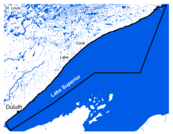Lower Shore: Duluth to Two Harbors
The winds last week kept most small boats off the lake, but larger vessels were still able to get out and do some fishing. The winds and cooler air temps led to cooler surface water temps in the upper 50’s. Lake Trout fishing was good on the nice days trolling hot color spoons, flasher fly rigs, and especially meat rigs 150 feet down in 200+ feet of water. Jigging in the Two Harbors area was also rather good this week, at those same depths. Pink Salmon were reported from most stations and observed in several of the larger rivers. Coho and Chinook Salmon catches remained low from all stations. It is the last weekend of the Lake Trout season, which closes on October 6th and opens again on December 1st.
Upper Shore: Twin Points to Hovland
Surface water temps were in the low 60’s and extended deep into the water column. Anglers reported good fishing for Lake Trout from Grand Marais and Hovland and slower fishing further down the shore. Lake Trout were holding in deep water and larger fish were not very responsive to lures. Anglers from Grand Marais and Horseshoe Bay reported more smaller Lake Trout, from 16-20 inches which was uncommon this summer. Anglers also reported catching more Siscowets. Very few Salmon were reported from any station except for a single Chinook from Grand Marais. Pink Salmon were observed spawning in the Baptism, Temperance, Cascade and Brule rivers, although most showed signs of deterioration.
Management Update: Sea Lamprey Abundance
Anglers have seen an increase in the number of Sea Lamprey and Sea Lamprey wounds on fish caught in Lake Superior this year. The U.S. Fish & Wildlife Service and Fisheries and Oceans Canada are the two Federal agencies tasked with Sea Lamprey assessment and control under the auspices of the Great Lakes Fishery Commission. In 2020, thirty tributaries around Lake Superior were scheduled to be treated to kill larval Sea Lamprey before they become parasitic and feed on fish. However, only 10 of those tributaries were treated due to travel restrictions associated with the COVID-19 pandemic. Unfortunately, this increase in adult Sea Lamprey abundance, increased wounding on Lake Trout, and an increase in the number of fish killed (each Sea Lamprey consumes 40 pounds of fish in its lifetime) was anticipated but should be short-lived. Treatments on Lake Superior tributaries have since resumed and anglers should notice fewer Sea Lamprey and Sea Lamprey wounds on fish over the next few years.
For more information on Sea Lamprey control in the Great Lakes check out the Great Lakes Fishery Commission website and the most recent report Sea Lamprey Control in the Great Lakes 2023 from the U.S. Fish and Wildlife Service and Fisheries and Oceans Canada
Helpful Links
 Questions?
Visit us online at mndnr.gov
If this message was shared with you, sign up to receive it at the link above.
Email us at Lake Superior fishing report
Give us a call at 218-302-3277
Fishing report hotline at 218-302-3293
Report suspicious activity at 800-652-9093
|